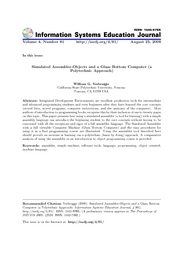Volume 4
Volume 4, Number 61 |
August 23, 2006 |

|
William G. Verbrugge
|
Abstract: Integrated Development Environments are excellent production tools for intermediate and advanced programming students and even beginners after they have learned the core concepts (stored data, stored programs, computer instructions, and the anatomy of the computer). Most authors of introduction to programming books recognize this by their inclusion of one to twenty pages on this topic. This paper presents how using a simulated assembler (a tool for learning) with a simple assembly language can introduce the beginning student to the core concepts without having to be concerned with all the exceptions and rigor of a full assembler language. The Simulated Assembler with a full viewable Computer Machine (Glass Bottom Computer) and the easy procedures for using it in a first programming course are illustrated. Using the assembler tool described here should provide an increase in learning via a polytechnic (learn by doing) approach. A comparative analysis of using the assembler in an introduction to object programming course is provided.
Keywords: assembler, simple machine, software tools, language, programming, object oriented, machine language
Download this issue: ISEDJ.4(61).Verbrugge.pdf (Adobe PDF, 11 pages, 970 K bytes)
Preview the contents: Verbrugge.j.txt (ASCII txt, 21 K bytes)
Recommended Citation: Verbrugge (2006). Simulated Assembler-Objects and a Glass Bottom Computer (a Polytechnic Approach) Information Systems Education Journal, 4 (61). http://isedj.org/4/61/. ISSN: 1545-679X. (A preliminary version appears in The Proceedings of ISECON 2005: §2524. ISSN: 1542-7382.)